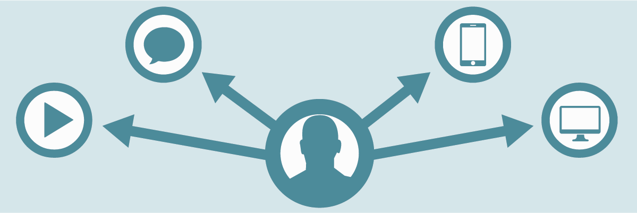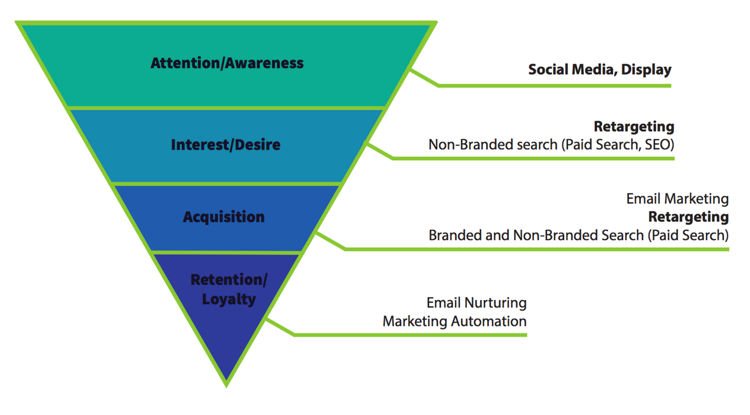Breaking Down an Effective Digital Advertising Strategy

Before coming to Choozle, a digital advertising platform, I knew enough to be dangerous in conversation, but if you had really put me on the spot I would have crumbled into an embarrassed mess. Ignorance (and likely over confidence) is a beautiful thing since despite my then shallow knowledge of digital, I took a job at Choozle teaching our clients how to run digital advertising campaigns. Sink or swim, eh?
The truth is, you just need to start somewhere and it’ll come. Digital can be scary given its constant evolution, acronyms galore, and fragmentation within the industry. My role at Choozle, at its core, is to help make digital accessible to marketers and provide them the tools to run successful marketing campaigns themselves. So, I am going to break down how I approach developing a strong digital campaign strategy from a thirty thousand foot view.

First, why run a digital ad campaign? It’s more expensive than printing off some flyers at the local Kinkos, sure, but in comparison to a TV spot or most other traditional channels, digital is a heck of a deal to get your message out there. It also allows you to better target your key audiences which, among other benefits, cuts out the waste of advertising to those not in your intended target pool. Another huge plus is the access to a large amount of data telling you how to target, how your campaign did, and how to make it better.
The most obnoxious line in digital: “ It depends”. I know, I know and I admit that I likely say this phrase everyday. Digital is not one size fits all though. Given a few major parameters to your campaign, my suggestions for you are going to change, which brings me to my first tip. Before getting anything set up, nail down your budget, your objectives, time frame and your target audience(s). Don’t have all these established? Understand your objective at the very least and that will help back into the rest. Seems like common sense, but I see it all the time.
Online Advertising Evolved
A large part of early digital display advertising (i.e. image-based) was direct buys where you would go to the rep at say, ESPN and pay a premium to take up a certain amount of ad space on their site. You did this of course, because you believed this brand-friendly site was where your target audience was spending time online. Within the last five or so years, the introduction of “programmatic” advertising to digital was made. Programmatic is a fancy way of saying “automation” and spans different mediums beyond digital, such as its recent expansion into Television.
“Real-time bidding”, or “RTB” is the digital form of programmatic. Think of RTB like an auction room where your bid is up to you and only the other bidders in the room are standing between you and the prize. In RTB, instead of paying the set premium as in my ESPN example, you now are able to say, “I am going to bid $2.00-5.00 for my target audience on these types of sites, at this time of day, on this section of the website, etc.”. The customizations you can place on your “order” are vast and the most beautiful thing about RTB is that the whole process is automated. No more passing spreadsheets back and forth with a rep, you can control the campaign directly from different platforms, such as Choozle (shameless plug) that have pipes into the open exchanges, or essentially the gatekeepers of the advertising placements. Direct buys are, of course, still a valid tactic, but RTB opened the door for marketers of all budgets and targets.
Then there’s Google's Adsense. Given the giant that is Google, I am not going to go into much detail other than outlining Search ads as a product that allows marketers to advertise via text-based ads based on what users are searching for. Beyond display and search, you have social, such as Facebook marketing, email marketing and SEO (search engine optimization). There are many more channels and types of advertising you can explore, of course, but I’m going to stop here for brevity’s sake.
Digital Advertising Meets Marketing Strategy
At this point, I want to introduce a really important concept I call the customer acquisition funnel (see visual below). The top of the funnel signifies where customers enter the relationship with your brand and the bottom represents both the acquisition (i.e. They did what you wanted) and the ongoing relationship. Understanding what channels serve which part of this funnel will help you decide what channel(s) you need in your digital advertising strategy. For example, is your main objective awareness? If so, then top of funnel channels like social and display will allow you to most effectively “spread the good word”.

When I run through this, I sometimes get, “Cool, Rachel, so I actually just want people to buy stuff so I’ll just do Search, sound good?”. Thanks for asking, imaginary client, and not exactly what I’d recommend, no.
Let’s think of this like selling a house. If you spend all your money on the open house snacks and emailing the 3 people your mom and brother-in-law passed along, you better hope one of those 3 people buys your house, yeah? And what if you have 5 houses to sell? Isn’t it much smarter to spend part of your money and time to post on Zillow, print flyers, and then spend the rest on delicious snacks and communicating with interested buyers that come to the open house? Still following me? My point is most marketers should employ a mix of these channels and tactics to get the best results based on their objective(s).
This is where it becomes crucial to determine your budget, key audience, and time frame for the campaign. Not sure on budget? Use your objective to back into this number, even if rough. You want to increase sales 15%, for example, use that, along with industry conversion rates (your historical rates are even better) to get back to a figure. Retargeting and search tend to be more expensive tactics over display, for example, so I always recommend balancing your tactic/channel mix based off objective and budget. Your key audience should be a somewhat easy checkbox. You sell cars; you want people who are looking for a car. If you don’t yet have the intel, start broad and make sure you put in tools like Google Analytics at least or more advanced audience analytics tools to capture the leads from your campaign to hone more in on your audiences over time.
Time frame is important to consider when you want to run a more involved tactic like retargeting. Retargeting requires you to place a tag on your site and collect visitors to target again to. Retargeting should really be set up a minimum of 30 days prior to launch and even then, it takes time to ramp up. If you have two weeks and five hundred bucks I wouldn’t recommend running it all on retargeting. You’ll get a better bang for your buck with display since the reach is immediate and much wider in most cases.
Executing a Successful Campaign
The more time and effort you put into the set up, the easier optimizing the campaign will be. If nothing I’ve said stays with you, please remember to diversify your campaign.
Don’t set up one channel targeting one audience profile. If that set up tanks, you get to start from scratch. Make a couple versions of your creative or at least have a couple messaging/visual options on back up. It’s nice to have another version to test and if you’re doing this for a client, it’s always a welcomed deliverable to show them what is and isn’t working creative-wise. This translates to all corners of their marketing.
Let’s talk tracking next. Make sure whatever tools you select to help you execute your campaign allow you to see behind the curtain and gain learnings to make the next campaign even better. If you are running multiple campaigns on different tools, make sure you have tracking in place to distinguish between them. Google Analytics, MOAT, and many other industry tools allow for even further tracking via creative units to give you better detail on performance, including additional brand safety for some. Tracking also allows you to let the data talk. Arguing with your client on who their target audience is? Let the data prove it. Data from leads is gold. Making sure you have a lead gen form set up, marketing automation enabled, and tracking pixels set for retargeting to start will be gifts that keep on giving.
I’m keeping it quite broad, I know, but understanding your desired outcome in detail, what channel/tactic mix to start with and what data you want out of your efforts prior to launch will allow you to more effectively select the right companies to partner with, set you up for continued learnings and otherwise become a kick-ass digital marketer.
Repeat after me: Invest in set up, diversify, and track.
Have other ideas? Let me know in the comments below!

-Rachel Mimken, rachel@choozle.com.
See how digital advertising can boost the results of your digital marketing strategy:
About Author
Rachel Mimken
Stay up to date.
Subscribe for periodic updates on the latest happenings in life science and healthcare marketing.
Subscribe Here!
Related Posts
Ingenuity is about being clever, original, and inventive. It means finding a way to accomplish your goals
BY Guest Author
BY Guest Author
Lead generation, the art of attracting potential custom...



Comments